9+ SAMPLE Call Center Training Proposal
-

Call Center Services Training Proposal
download now -
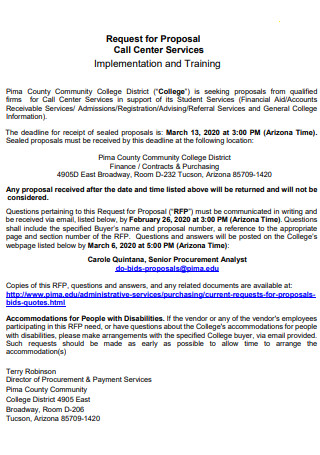
Call Center Training Request for Proposal
download now -
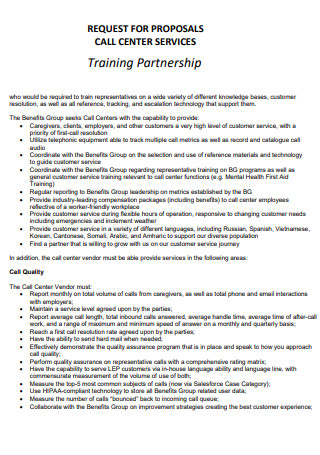
Call Center Training Partnership Proposal
download now -

Sample Call Center Training Proposal
download now -
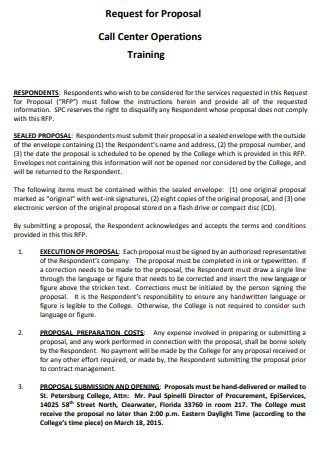
Call Center Operations Training Proposal
download now -
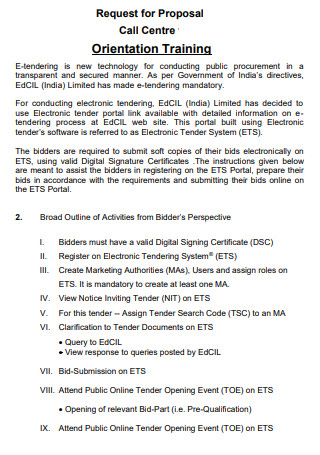
Call Center Orientation Training Proposal
download now -
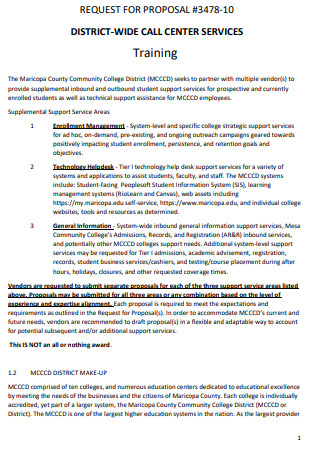
Standard Call Center Training Proposal
download now -
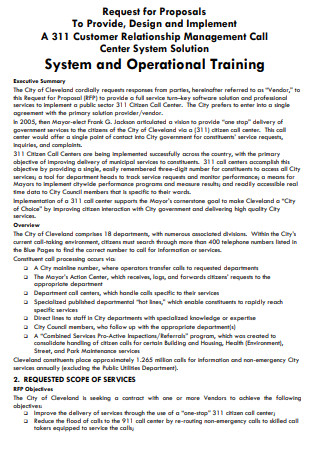
Call Center Management Training Proposal
download now -
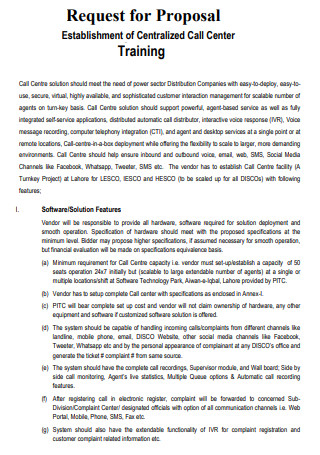
Call Center System Training Proposal
download now -

Call Center Training Business Proposal
download now
FREE Call Center Training Proposal s to Download
9+ SAMPLE Call Center Training Proposal
Call Center Training Proposal: What Is It All About?
4 Effective Call Center Training Tips – What to Teach Your Employees
Making the Call Center Training Proposal
FAQs
What are some of the methods used in call center training?
What are some of the traits that make up a good call center employee?
What are some of the challenges encountered by a call center company?
Call Center Training Proposal: What Is It All About?
A call center training is where agents, or employees, are trained on the proper etiquette on how to handle incoming or outgoing calls from existing or potential customers. The training usually includes product knowledge, customer handling skills, and product troubleshooting. A call center training proposal is a document that seeks to get the approval of decision-makers on a proposed training plan or program for call center employees. Organizations often invest in training programs to enhance employees’ professional development, either to make them ready for a much bigger role within the company, to introduce new product and skills knowledge or else simply just as a refresher course. Call center employees, before they even go near to taking calls, have to undergo comprehensive time-bound training. They will be equipped with the proper knowledge of the company’s products, and most especially be trained on how to handle different kinds of customers.
4 Effective Call Center Training Tips – What to Teach Your Employees
Needless to say, the employee is a representation of what the overall company outlook is. The employee represents the company’s products and services and most significantly represents the company’s culture and values. Choosing someone to face and handle the customers is an important decision to be made. Especially when it’s answering calls or making outbound calls, or even corresponding online, you need someone to represent the company that has the right communication skills. Not all the time you get customers who are charming and polite. More often than not, you’ll get to encounter those irate customers who have no lack of curse or swear words to knock you off your socks! Life in a call center is one big roller coaster or a big roulette wheel of the lottery: you’ll never know whom you’re going to get at the other end of the line! So, what do you need to teach your employees, so that they’ll know how to arm and guard themselves against answering and making calls? Seriously though, what do your employees need to learn to be effective call center agents that customers just love talking with?
Making the Call Center Training Proposal
Before training begins, a training proposal needs to be made. The call center training proposal shows and justifies the need for a training program, whether it be done as internal training or a third party-led training. A lot of factors are considered before a proposal is even approved, and the two of the most important factors are time and budget. The time spent on training is, of course, at the company’s expense. Questions like can the company afford to have the employee go on several hours or days of training and who to temporarily replace the employee is brought up. Budget questions also come up, such as how much will it cost the company to hire third-party trainers, or what will be the resources needed or to be spent when it comes to doing the training. All of that is laid out in the proposal. When planning to make one, here are the key elements to be included when it comes to creating that call center training proposal.
-
Step 1: Executive Summary
An Executive Summary provides a brief overview of the training proposal. It provides a brief background description of the agency handling the training if it’s a third-party agency. If it’s an internal training team, the executive summary provides a brief description of what is the reason or the need to have a training program. It highlights the causes, the issues if there are any, and a summary overview of the training agenda. It also presents the training team’s expertise as a way of introduction, as well as touches a bit about the cost related to the training. Some training proposals utilize a mission statement in their executive summary. A Mission Statement describes the purpose and the initiative of the training proposal, and also reflects upon the culture and values of the company.
-
Step 2: Training Approach
This is the section where you present the details of the training program. The goal of the training should be quantifiable, or at best, should be SMART (Specific, Measurable, Achievable, Relevant, and Time-bound). Firstly, provide a proposed schedule of how long the training will take, and if there is any follow-up training or monitoring that needs to be scheduled as well. Next, identify who the participants are. It can be old call center employees or newly hired call center employees. Include as well if the training will be done in batches or not based on the number of participants. Afterward, provide the topics or methods that will be tackled during the duration of the training. The topics can be broken down as per schedule. For instance, Day 1 morning session is a discussion on company products and services. Day 1 afternoon session is a discussion on what are the anticipated queries or concerns coming from the customers. Day 2 morning session is all about phone etiquette and customer interaction. Day 2 afternoon session is all about discussing the key performance indicators. Day 3 is training application and practices. And so forth.
-
Step 3: Evaluation and Monitoring
Decision-makers usually would love to see a projection of the training’s outcome. It is best to include in the proposal how you are planning in measuring, monitoring, and evaluating the progress of the call center trainees. Provide a monitoring log. It could be in a format where it shows the action of the trainee that was monitored, what are the highlights of the action, and what aspects need to be improved. Not only should the log serve as a monitoring sheet, but it should also be a growth development plan for the employee.
-
Step 4: Costs and Expenses
What are the costs and expenses to be incurred in doing the training? This is what needs to be presented in the proposal. A breakdown should be prepared. From the materials, tools, and equipment, rental costs of the training facility, trainer’s fee (if any), meals during the training, trainees’ stipends, and any other expenses that usually stem from doing training. This will also be the basis later on for the amount of budget that needs to be approved to conduct the training.
-
Step 5: Terms and Conditions
The terms and conditions lay out the obligations of all the parties involved. In the case of a call center training proposal, it provides the roles and responsibilities of the training party, the participants, or the trainees, and the management or companies involved. The provisions found in the terms and conditions provide a guarantee and a safety net in case of unforeseen circumstances that will affect the implementation of the training program. Usual provisions included are Confidentiality Agreement, data protection, intellectual property, privacy, force majeure, cancellation, Termination Agreement, and disputes.
FAQs
What are some of the methods used in call center training?
Shadowing method happens when newly hired call center trainees would sit side by side with the tenured employees and listen live while they’re taking or doing calls. It is one way of observing what are the best practices when doing calls, as well as observing the proper customer handling and troubleshooting skills. Another method is tools management. There are a lot of tools involved when taking or making calls. There are tools for the virtual or manual phone, tools for tracking and recording customers’ requests, and tools for troubleshooting. Learning how to multitask and to manage all the different tools is an important skill to learn during the training program. Q&A, or Quality and Analysis feedback is also another important method. This is learning about what are the key performance indicators, learning how to apply them, and learning as well how the trainees will be monitored, evaluated, and scored.
What are some of the traits that make up a good call center employee?
The first one is having good communication skills. A good communication skill means knowing how to listen and be empathetic when a customer has an issue about a product or service, and at the same time must also know how to deftly and skillfully lead the conversation towards offering a solution. The next important trait of a good call center employee is having the capability and the resilience to handle difficult calls or handle pressure. Never a day goes by that a call center employee will not receive any kind of difficult calls, especially coming from mad as hell customers. A skilled employee knows how to deal with angry customers, knows how to deal with the mental and emotional pressure when experiencing those types of calls, and at the same time strives to meet the KPIs set by the management. Another important trait is the ability to multitask. This refers to the ability to use the different tools and functions when taking inbound calls or making outbound calls in a given timeframe. Last but not least, another significant trait is being a good problem solver. Call centers usually rely on scripted troubleshooting methods, but sometimes there are problems or concerns not tackled by the script that the employee needs to think of quick and fast and out-of-the-box solutions to provide customer resolutions.
What are some of the challenges encountered by a call center company?
One of the challenges encountered by a call center company is the language barrier. A product user sometimes might not be fluent in the English language and would have a challenging time trying to explain what their concern is all about. Other challenges include the customer handling skills and the turnaround time when handling calls. Customer handling is all about customer interaction and customer satisfaction, and this will be reflected upon the surveys or feedbacks and reviews that the customer will be making if they’re satisfied with how the employee handled their concern or not. Turnaround time is how long the employee engages in a call. Call centers are often paid by the number of calls that they are expected to meet and receive, so, therefore, the more calls the employees handle, the better it is for the call center company. Turnaround time is affected, for instance, if an employee took too long in handling a call because of an irate caller, or had difficulty trying to troubleshoot a particular concern.
Talking to a human is what callers preferred the most when calling up a company’s hotline contact number to ask about a product or a service. That’s what call centers are being geared up for. They’re trained and equipped with the necessary knowledge of the company’s products and services, as well as the skills and qualities needed when interacting with the customers. Before a training takes place, there needs to be a proposal prepared, detailing the purpose, methods, and other details when implementing a call center training program.
Given the task of creating a call center training proposal? Our ready-made training proposal templates can help you out there. Our templates are easy to fill out and made ready for download so that you can use this when making your proposal presentation. Download one now, and start creating that call center training proposal that easily gets that sign-off and nod of approval!
